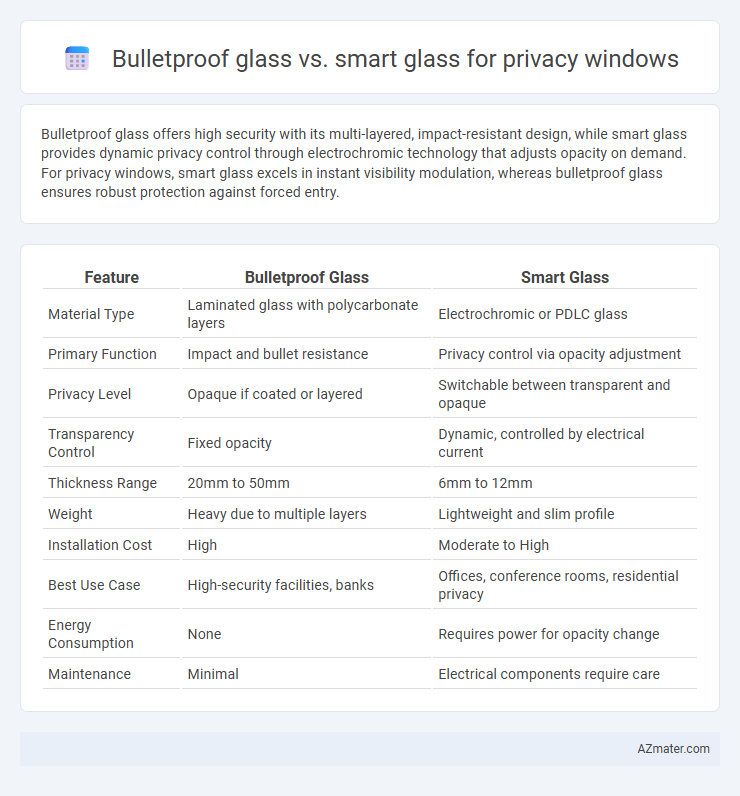Bulletproof glass offers high security with its multi-layered, impact-resistant design, while smart glass provides dynamic privacy control through electrochromic technology that adjusts opacity on demand. For privacy windows, smart glass excels in instant visibility modulation, whereas bulletproof glass ensures robust protection against forced entry.
Table of Comparison
| Feature | Bulletproof Glass | Smart Glass |
|---|---|---|
| Material Type | Laminated glass with polycarbonate layers | Electrochromic or PDLC glass |
| Primary Function | Impact and bullet resistance | Privacy control via opacity adjustment |
| Privacy Level | Opaque if coated or layered | Switchable between transparent and opaque |
| Transparency Control | Fixed opacity | Dynamic, controlled by electrical current |
| Thickness Range | 20mm to 50mm | 6mm to 12mm |
| Weight | Heavy due to multiple layers | Lightweight and slim profile |
| Installation Cost | High | Moderate to High |
| Best Use Case | High-security facilities, banks | Offices, conference rooms, residential privacy |
| Energy Consumption | None | Requires power for opacity change |
| Maintenance | Minimal | Electrical components require care |
Introduction to Privacy Window Technologies
Privacy window technologies include bulletproof glass, which offers high security by combining multiple layers of laminated glass and polycarbonate for impact resistance, and smart glass, which utilizes electrochromic or liquid crystal technology to switch between transparent and opaque states for instant privacy control. Bulletproof glass is primarily designed for protection against physical threats, while smart glass focuses on dynamic privacy and energy efficiency by controlling light transmission. Both technologies cater to different privacy needs, with bulletproof glass ensuring safety and smart glass enhancing privacy adaptability in residential and commercial spaces.
What is Bulletproof Glass?
Bulletproof glass is a type of laminated safety glass designed to withstand high-impact forces, typically composed of multiple layers of glass and polycarbonate materials that provide ballistic protection. It is commonly used in security-sensitive environments such as banks, military vehicles, and government buildings to prevent intrusion or damage from firearms. While bulletproof glass focuses on physical security, it does not offer privacy features like the opacity control found in smart glass technology.
What is Smart Glass?
Smart glass, also known as switchable glass, uses electrochromic, photochromic, or thermochromic technologies to change transparency on demand, providing instant privacy without sacrificing natural light. Unlike bulletproof glass, which prioritizes physical protection against impacts and ballistic threats, smart glass enhances privacy by dynamically adjusting opacity through electrical control. This technology is ideal for privacy windows in offices, homes, and medical facilities, offering energy efficiency and customizable visibility while maintaining sleek aesthetics.
Security Features: Bulletproof vs Smart Glass
Bulletproof glass provides enhanced security features by offering high resistance to ballistic impacts, preventing forced entry and protecting against gunfire. Smart glass enhances privacy through electrochromic or switchable technology, allowing instant opacity changes but lacks physical reinforcement against intrusions. For security-focused privacy windows, bulletproof glass offers superior protection, while smart glass prioritizes adaptive privacy control.
Privacy Control and Customization
Bulletproof glass provides strong physical protection but offers limited privacy control, as it remains transparent and cannot adjust opacity. Smart glass enhances privacy customization by switching between clear and opaque states with an electric signal, allowing users to control visibility dynamically in real time. Combining smart glass technology with bulletproof materials can deliver both robust security and adaptable privacy solutions for windows.
Energy Efficiency Comparison
Bulletproof glass offers high security but typically has lower thermal insulation properties, leading to increased energy consumption for heating and cooling. Smart glass enhances energy efficiency by dynamically controlling light transmission and heat gain, reducing reliance on HVAC systems. For privacy windows, smart glass provides superior energy savings through adjustable opacity without compromising on insulation quality.
Cost Analysis: Initial and Long-Term
Bulletproof glass generally has a higher initial cost, ranging from $50 to $100 per square foot, due to its multi-layered construction designed for security and impact resistance, while smart glass typically costs between $40 and $70 per square foot, incorporating advanced electrochromic technology for adjustable privacy. Long-term costs of bulletproof glass include minimal maintenance but potential high replacement expenses if damaged, whereas smart glass incurs ongoing energy expenses from power consumption and possible higher maintenance for electronic components. Evaluating cost-effectiveness depends on prioritizing security with durable investment or dynamic privacy with energy and technology considerations.
Aesthetics and Design Flexibility
Bulletproof glass offers a robust, clear surface ideal for maintaining an unobstructed aesthetic while providing maximum security, but it is limited in design customization options. Smart glass enhances privacy through dynamic opacity control, enabling seamless transitions between transparent and frosted states that complement modern interior designs. Its versatility in shape, size, and integration with digital controls provides greater flexibility for creative architectural and decorative applications.
Installation and Maintenance Considerations
Bulletproof glass requires professional installation due to its heavy weight and thickness, often necessitating reinforced frames and specialized hardware, while smart glass installations involve integrating electronic components and wiring, which can complicate retrofitting in existing structures. Maintenance of bulletproof glass centers on cleaning and inspecting for surface damage without compromising its protective integrity, whereas smart glass demands regular checks on electrical systems and occasional software updates to ensure optimal opacity and privacy functionality. Choosing between the two depends on balancing structural reinforcement needs against technological upkeep for privacy window applications.
Which Privacy Window Solution is Best for You?
Bulletproof glass offers maximum security by resisting forced entry and ballistic threats, making it ideal for high-risk environments requiring physical protection. Smart glass provides adjustable privacy through electrochromic or switchable technology, allowing users to control transparency and maintain natural light without compromising confidentiality. Choosing the best privacy window depends on whether security or dynamic privacy control is the priority for your specific application.

Infographic: Bulletproof glass vs Smart glass for Privacy window
 azmater.com
azmater.com